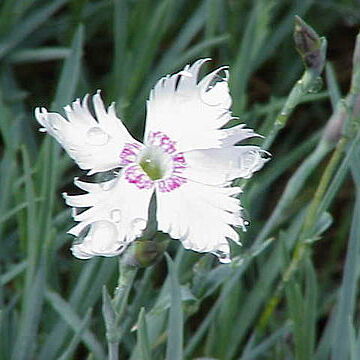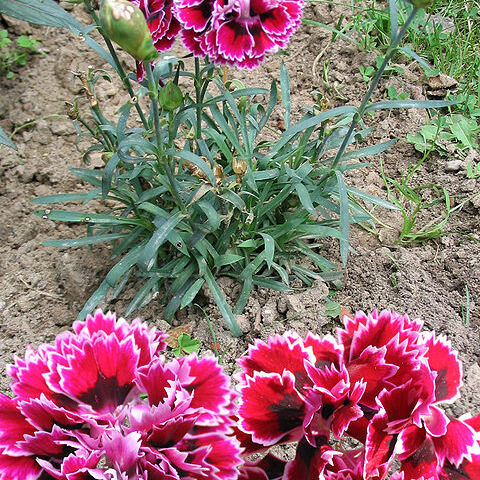Herbs, perennial (rarely annual) or (some non-Australian species) small undershrubs, often glaucous, often with swollen nodes. Leaves opposite, usually ± linear and parallel-veined; bracts herbaceous, leaf-like. Flowers solitary or in few-flowered cymes, 5-merous, unisexual or bisexual. Epicalyx present as 1–3 pairs of awned scales. Calyx tubular, cylindrical, not strongly veined, with scarious seams, 5-lobed. Petals 5, white, yellow, pink, red or purple or a combination of these colours, long-clawed, exceeding calyx, dentate or lacinate, often with a tuft of hairs near the base; coronal scales absent. Stamens 10. Ovary 1-celled; styles 2. Capsule cylindrical to narrowly ovoid, opening by 4 short teeth; carpophore very short, sometimes absent. Seeds several, ovate-scutate, dorsiventrally compressed, finely tuberculate or smooth.
Herbs perennial, rarely annual. Roots sometimes woody. Stems mostly caespitose, terete or angular, articulated, dilated at nodes. Leaves opposite, usually glaucescent, linear or lanceolate, veins parallel, base slightly connate, margin scabrid. Flowers solitary, several in a loose cyme, or numerous and clustered into capitula, subtended by 1--4 pairs of appressed bracts. Calyx cylindric, apically 5-toothed, veins 7, 9, or 11, without scarious commissures. Petals 5, purple, red, pink, or white; claw long; limb dentate or lacerate, rarely entire. Stamens 10. Ovary 1-loculed; ovules numerous. Gynophore long. Styles 2. Capsule cylindric, suboblong, or rarely ovoid, dehiscing by 4 teeth or valves. Seeds dorsiventrally compressed, orbicular or discoid, flat or concave; embryo erect; albumen eccentric.
Perennial or sometimes annual herbs. Hairs eglandular or glandular, or 0. Lvs opposite, exstipulate, usually linear or linear-lanceolate, often glaucous; cauline lvs connate in pairs. Fls solitary or in lax to compact cymes; bracts leaflike; base of calyx tightly enclosed in an epicalyx of 2-6 awned scales. Calyx tubular, usually at least 35-ribbed, 5-toothed, with green commissures. Petals 5, white, pink or red, clawed, usually toothed or fringed, often bearded; coronal scales 0. Stamens 10, in 2 equal or unequal whorls. Styles 2. Fr. a cylindric capsule dehiscing by 4 teeth; carpophore usually present. Seeds flattened, scutate, finely grooved, not winged.
Annual or perennial herbs, often with woody base. Stems usually thickened at the nodes. Leaves opposite, narrow, leaf pairs connate at the base. Flowers solitary or in few-to many-flowered cymes, lax or dense, forming heads. Calyx surrounded by 2-4 or more epicalyx scales. Calyx cylindrical, of varying length, up to 35 mm, finely striate, 5-dentate. Petals with a long narrow claw widening into a broadly ovate or fan-shaped lamina, entire, dentate, fimbriate or deeply dissected; coronal scales absent. Stamens 10. Styles 2. Capsule mostly cylindrical, dehiscing with 4 teeth. Anthophore usually present. Seeds peltate, with a facial hilum, embryo straight.
Herbs or subshrubs. Leaves exstipulate, generally “grass-like,” more or less connate at base forming a sheath above the often swollen nodes. Inflorescences terminating the flowering stems, cymose, panicled, or variously aggregated-capitulate; a varying number of pairs of calycine bracts surrounding the calyx. Calyx tubular, 5-toothed, with numerous longitudinal parallel veins. Petals 5, with a long narrow claw. Stamens 10 in hermaphrodite flowers or abnormally reduced in number. Ovary unilocular; styles 2, distinct from the base. Capsule cylindrical, oblong, or ovoid, opening by four apical valves or teeth.
Fls solitary or in open or capitate cymes; cal subtended by 1–3 pairs of bracts, cylindric, with 20 or more nerves; pet 5, without auricles or appendages; stamens 10; styles 2; capsule dehiscent by 4 teeth; seeds disciform, concave-convex, the hilum at the center of the concave surface; embryo straight; annual to perennial herbs. 300, Old World.
Annual, biennial or generally short-lived perennial, occasionally suffruticose herbs, generally with a woody tap root.
Calyx tubular, generally striate-nervose, 5-lobed, invested at the base by 1–12 pairs of calyx bracts.
Petals 5, claw of petal with two central longitudinal ridges (sometimes very inconspicuous).
Ovary ovoid, oblong or cylindric, placentation free-central; stigmas 2, free to base.
Internode between calyx and corolla (anthophore) variable.
Leaves exstipulate, usually linear or linear-lanceolate.
Flowers solitary, fasciculate or clustered into heads.
Stamens 10, united at the base into a short ring.
Capsule with 4 equal teeth.
Inflorescence cymose.
Gynophore short.


